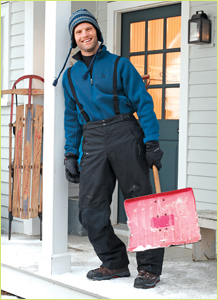Discover how to brave the cold and stay active all winter long.
When it comes to exercising and staying active, many of us just aren't keeping up—and the numbers prove it. For example, the Centers for Disease Control and Prevention reported that 36 percent of U.S. adults didn't engage in any leisure-time physical activity in 2008. And in winter, even those who are somewhat active turn more sedentary as their exercise time plummets along with the temperature.
That's too bad, because we need to maintain good health year-round, which means staying active even when it's cold outside. In fact, according to the U.S. Department of Health & Human Services' 2008 Physical Activity Guidelines for Americans, adults should do a minimum of 2½ hours of moderate or 1 hour and 15 minutes of vigorous aerobic activity each and every week. Plus, they should do strength training two days a week that works all major muscle groups: legs, hips, back, chest, stomach, shoulders, and arms.
Granted, it's challenging to go for a jog if the roads are icy, or to drive to the gym if you have to brush a foot of snow off your car first. And, yeah, it's way easier to be like a bear and hibernate 'til spring. But that doesn't mean you should! With the right plan and the right attitude, you can have an active winter and reap the rewards of a healthy lifestyle.
Get your body moving
Maintaining outdoor activities can help cure the winter blues, eliminate cabin fever, and boost your immune system—so you'll get sick a lot less if you exercise a little more. A study published in the American Journal of Medicine reported that women who walked for a half-hour every day for one year had 50 percent fewer colds than women who didn't exercise at all. (Researchers concluded that the regular walking increased infection-fighting white blood cells in the active group.)
The good news is that exercise is classified as anything that gets your body moving. So many of the fun things we associate with being outdoors in winter are healthy, too. Here are a few examples of cold-weather activities along with the amount of calories a 150-pound adult would burn doing each for an hour:
Ice skating or sledding: 476 cal./hr.
Having a snowball fight: 319 cal./hr.
Building a snowman: 285 cal./hr.
Making snow angels: 214 cal./hr.
Of course, some of the not-so-fun wintertime things can have health benefits as well. For example, shoveling snow for an hour burns 408 calories. But be careful if you're sedentary or out-of-shape. Shoveling wet, heavy snow for 10 minutes is equivalent to running on a treadmill until exhaustion. Most people who have heart attacks shoveling have no history of heart disease, so don't overdo it and don't ignore the warning signs. According to the American Heart Association, the signs that can mean a heart attack is happening include chest discomfort, pain or discomfort in one or both arms, the back, neck, jaw, or stomach, and shortness of breath. Other red flags include breaking out in a cold sweat, nausea, and lightheadedness.
If you or someone you're with exhibits these warning signs, stop shoveling and don't wait longer than a few minutes (no more than five) before calling 9-1-1. In fact, if you have any health concerns, it's a good idea to get your doctor's OK before you start exerting yourself.
Stay motivated
The key to staying in shape is to find activities that you enjoy. If it's fun, you're more likely to stay motivated and to stay active. And remember to mix things up throughout the winter so you don't get bored.
The great indoors
Still not psyched to go outside this winter? Snow problem. You've still got options to keep active and get healthy.
- Join a health club and get access to a wide assortment of equipment as well as certified fitness trainers.
- Create an inexpensive home gym. A set of dumbbells, some resistance bands, and an exercise ball are all you need to work out without leaving the house! (If you do go out, pick up a free exercise video at your local library.)
- Climb up and down stairs or stay active doing regular housework.
- Go to the mall and find a walking group to join and socialize with—it'll help keep you motivated.





